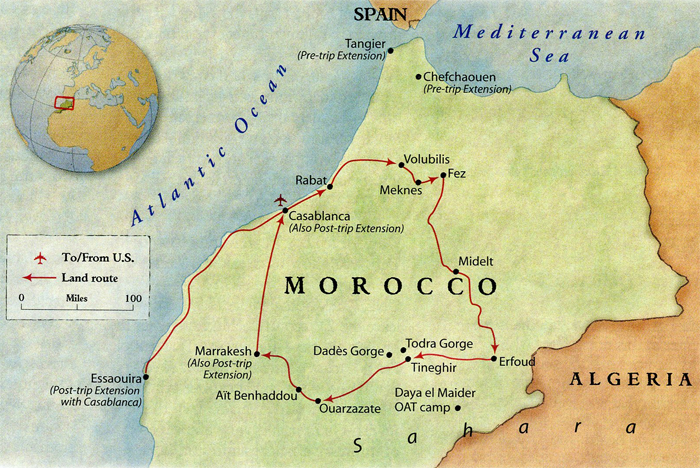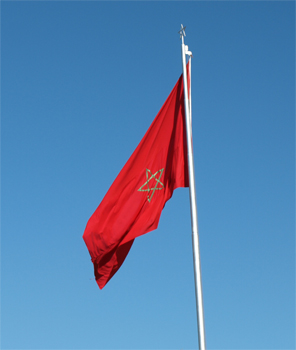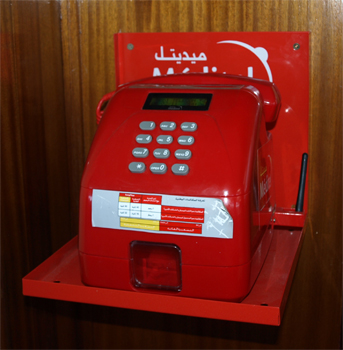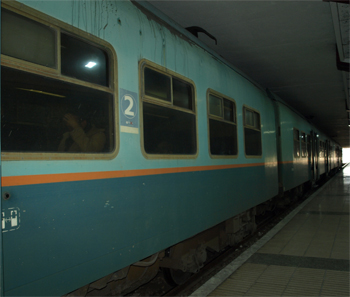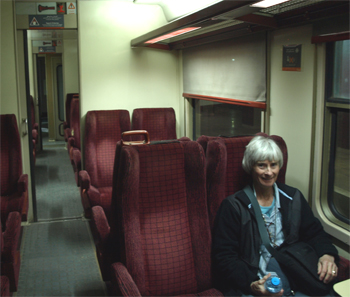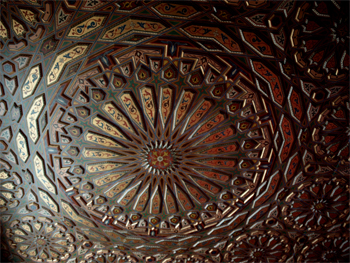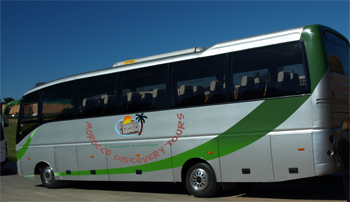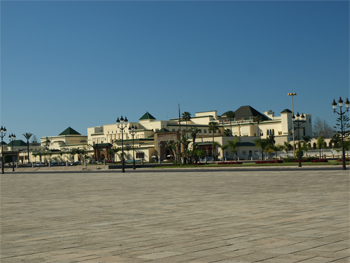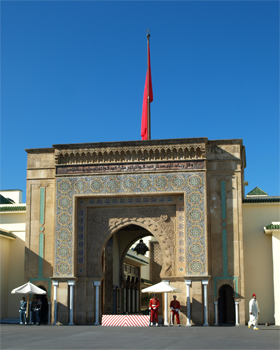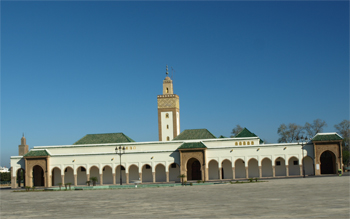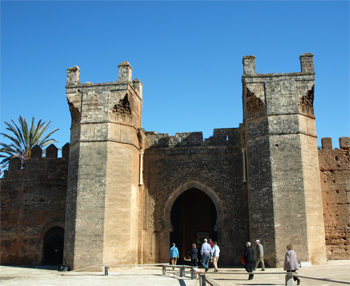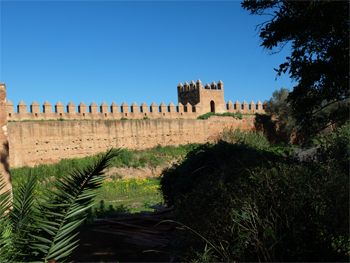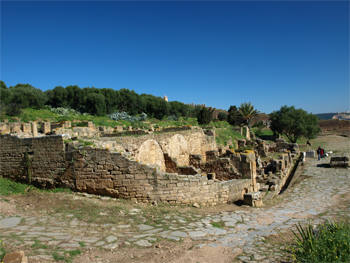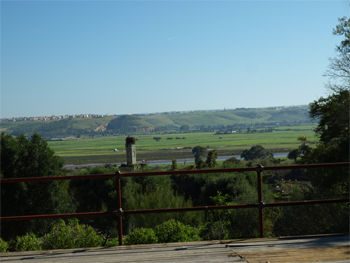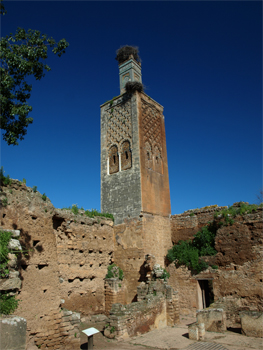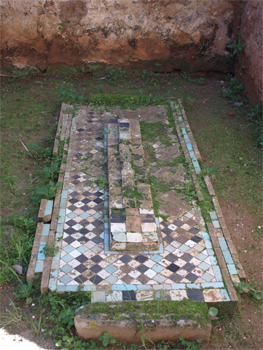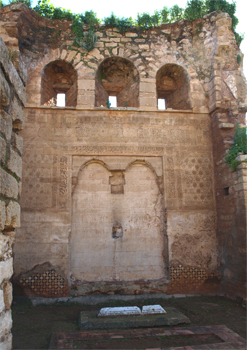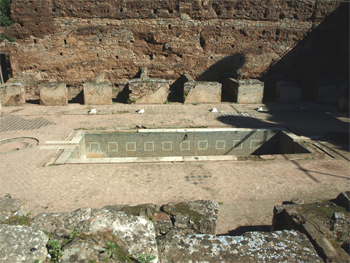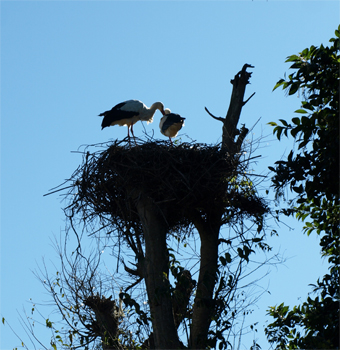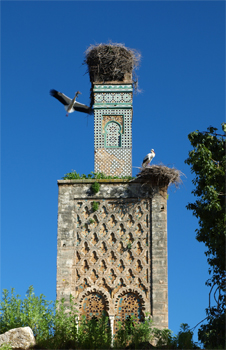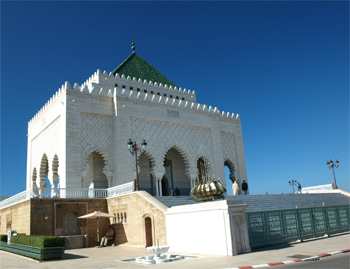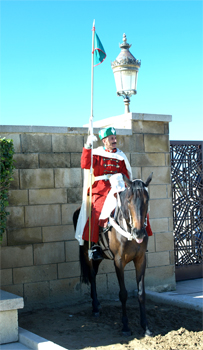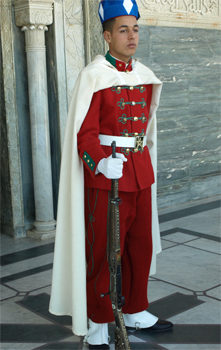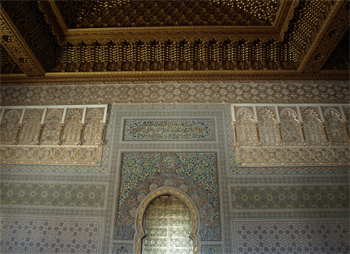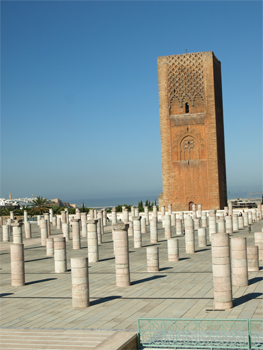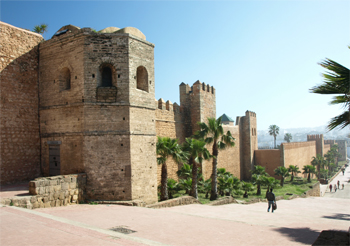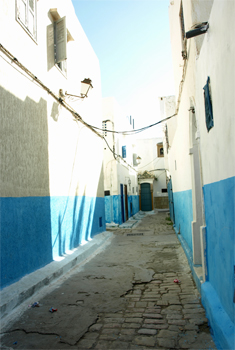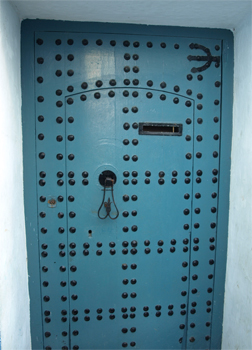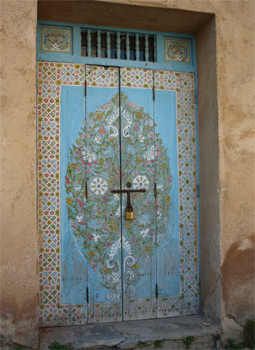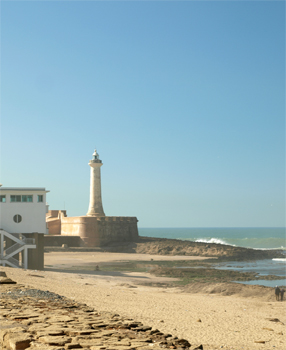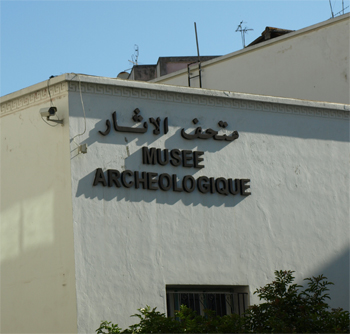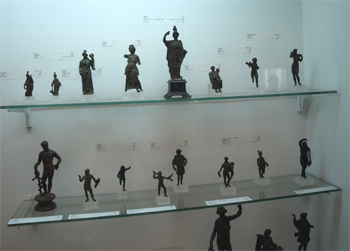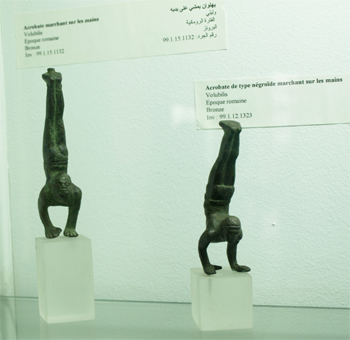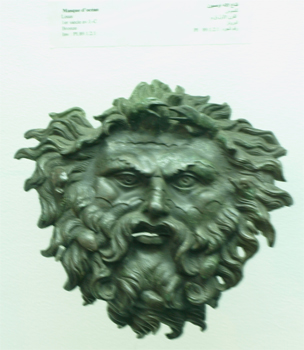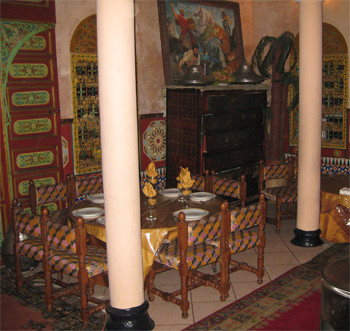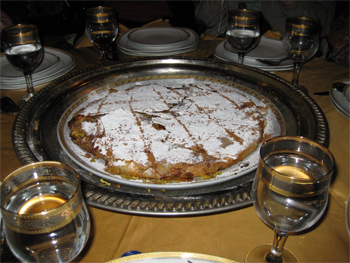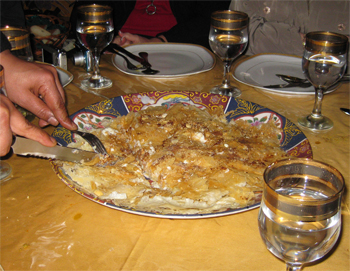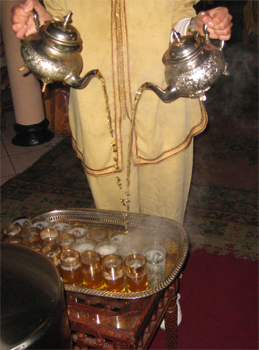We were in Morocco from February 4 to 21. It was a great experience. Lots to see - much of it quite different from Egypt. We had a lot of long days packed full of new and interesting things. The Moroccan tile work and wood and stucco carvings were exceptionally beautiful. We really enjoyed this trip, as well. There are lots of pictures here as this was also a very "photogenic" trip and selection for this presentation was difficult.
Please Note: If you go to a web link provided from within this site, you will need to use your BACK button to return here. If you are referred to a Looklex site, you may have to use your history list to get back.
Please enjoy - we surely did!!
Fri., 2/4/11 - Rome to Casablanca to Rabat
Back to the airport. Our flight on Alitalia was on time and only two thirds full. When we got to Casablanca at 11:30 AM customs and baggage were simple and not crowded - what a pleasure! We used an ATM machine in the airport and got more Moroccan dirhams, bought some bottled water, went to the train station attached to the arrival hall, and bought tickets to Rabat via Casablanca. It cost 75 Dh or about $9 each.
We got glimpses of the land as we approached Casablanca from the air. We crossed mountains (the High Atlas) with snow at the tops and then nice green farmland. I didn't realize Morocco was going to be such a contrast to the arid sand of Egypt. It is quite pleasing to see green.
Rabat was originally organized as a fortress with many barracks. King Moulay Ismail built the medina and made this the capital in the 17th century. Later the French (around 1912) added the new city (Ville Nueva). Rabat is one of the four Moroccan imperial cities and remained the capital when the French left in 1952. The architecture of the city is mixed Moorish and European.
Morocco was called Marrakech until 1912 when the French changed the name to Morocco. The population is composed of 60% Berbers (the natives from Eurasia), the Arabs came in the 8th c. and the Jews came in 500 BC. Arabic is the official government language and French is the commercial language. Children are taught 1/2 day in each language. The climate varies from moderate Mediterranean to snowy and cold in the high Atlas Mountains. Morocco has the second highest peak in Africa after Kilimanjaro.
University and all public education is free. Fifty percent of the population are farmers.
We changed trains in Casablanca with the help of some locals and continued on to Rabat. The train ride was comfortable. The train cars were well used. After a short taxi ride we arrived at the Hotel Rihab right in downtown Rabat at 2:45 PM.
Flag of Morocco The flag of Morocco is red, representing the iron rich soil, with a five-pointed green star in the middle. Green is the symbolic color of Islam.
|
Moroccan license plates are of many types |
Thank heaven for international signs!
|
Glad we didn't have to use this |
Airport to change for Rabat station
|
This was first class - we had to move to second class |
At dinner we met our group and our tour leader, Mohamed Amrabt, and had chicken, rice, and veggies for dinner. Little did we know that most of our lunches and dinners would be a combination of these ingredients. The others had all arrived at 6 PM from the States (11 of the 14 all the way from the West Coast) and were very tired and anxious to get to bed. We felt rested and ready to go. The night in Rome was recovery time!
After a buffet breakfast at the hotel we met for our trip introductions and orientation. Our tour guide, Mohamed, seems very organized and experienced - I think we will enjoy him. We also have an OAT (Overseas Adventure Travel) guide-in-training, Mustafa.
Mohamed
|
Ceiling of meeting room - a taste of the beautiful carvings we would see throughout the country |
Our chariot for the first part of our tour - until the Sahara desert camp
|
Our first stop on our city tour was at the Royal Palace. The grounds are beautiful and are open to the public from 7 AM to dusk. The government house built in the 18th century contains the palace. Over the entry gate to the palace complex is Arabic writing that says, "Make this door safe for all who enter and leave here."
|
Royal Palace |
Entrance and guards The palace is served by Sudanese servants who wear white robes, a red fez, and yellow slippers (look closely at the servant on the right). The palace is guarded by the Royal Guard (in red), the army (in olive green), and police (in blue uniforms).
|
Royal Palace Mosque and central square |
Morocco is a democratic social monarchy. There is a king who conducts ceremonies and has some political power. There is a bicameral parliament with an upper and lower chamber. Representatives are elected for five year terms. In 2000 the present king, who married a commoner, instituted a number of reforms giving the people more freedom of speech, freedom for the media, etc. He is well liked, unlike his father. The princess (they don't call her a queen) is very intelligent and is a trained computer geek. She does a lot of good for the country like establishing hospitals for children with cancer. Most Moroccans are Sunni Muslims of a very tolerant and moderate sect.
|
The second stop was at the Roman Necropolis of Chellah, an archeological site of a 14th century fort and necropolis. Early building on the site dates to the Phoenicians (third century BC) and to the Romans (40 to 250 AD). The French uncovered this Roman ruin. There are many foundations of storage rooms where items for export were collected.
Chellah entrance
|
Chellah fortress wall |
Ruins and minaret There are many foundations of storage rooms where items for export were collected.
|
Ruins of craftsman's quarters |
From this fortress we could see the Bou Regrege River separating Rabat from the suburb of Salle. The river flows from the Atlas Mountains to the Atlantic Ocean. |
Minaret and ruins
|
At this site is a 14 c. mosaic minaret and a small mosque or prayer room and the tombs of the 14 c. king and royal family. There was a school, like a university. The king at the time created several other universities or higher education for boys in Fez and Marrakech. These schools had dormitories for the students.
|
Royal tomb
|
Royal tomb
|
Ablution pool at school |
This area is also the home of hundreds of storks. There are large nests on every structure and tree.
|
The storks make a funny clacking noise by slapping their beaks together. |
Links http://en.wikipedia.org/wiki/Chellah http://www.megalithic.co.uk/article.php?sid=17910 http://lexicorient.com/morocco/rabat04.htm (Looklex site, you may have to use your history list to get back)
|
|
Next we went to the mausoleum of Mohamed V, grandfather of the present king. He was king when Morocco was freed from the French in 1952. He died in 1956 and a Vietnamese architect designed the beautiful, exotic, and extravagant mausoleum. Also buried there is Hassan II, father of the present king and Mohamed's brother.
Mausoleum of Mohamed V |
Mounted guard
|
Guard - so young!
|
Interior |
Interior tile work
|
The esplanade in front of the entrance includes the remains of the mosque damaged by the earthquake of 1755, which destroyed Lisbon, Portugal. The columns and half of the minaret are all that are left. The minaret has an interior ramp instead of steps for the Imam who rides a horse or mule up to the speaker for the call to prayer. |
Links http://lexicorient.com/morocco/rabat03.htm (Looklex site, you may have to use your history list to get back) http://lexicorient.com/morocco/rabat02.htm (Looklex site, you may have to use your history list to get back) http://www.galenfrysinger.com/maroc_rabat_mausoleum.htm (This site has great pictures and is very extensive.)
|
|
Next we walked through the Kasbah de Oudaias of the 12 c. medina. One end was the fort, the other end has housing with a garden in the middle. There were large storerooms to store grains for times of famine.
Wall of the Kasbah de Oudaias |
1195 Bab Gate
|
Houses are painted blue (for the sky) and white for the ocean
|
The alleys are stone cobbles and are twisted and hilly. The door knockers were interesting. Most were in the shape of scissors to cut the evil eye or the hand of Fatima, the daughter of the prophet Mohamed, to chase away the evil eye so it wouldn't enter that house. Link: http://lexicorient.com/morocco/rabat08.htm (Looklex site, you may have to use your history list to get back)
|
|
|
We ate lunch at a local seafood restaurant at the beach next to the Rabat Surfing Club. The tide was coming in and the waves crashed and spewed on the rocks and there was a lighthouse. Very pretty.
|
Royal surf club and lighthouse
|
After lunch we made a short visit to the Rabat Archeologic Museum. It contains some of the relics found at the Roman ruins of Volubilis that we will visit tomorrow. There were items from the Phoenicians and the Romans during their stay in Morocco. We especially liked the small bronze Roman statues of the Roman gods - Bacchus, Neptune, Hercules, etc., the mask of Neptune with fish and dolphins in his hair and beard, and some acrobats.
|
Roman gods |
Acrobats |
Neptune
|
On the way back to the hotel we stopped at a shopping mall and grocery store (Marjane) to buy wine and snacks to take to the desert in a few days. The wine is stored in a cooler under our motor coach. It was interesting to walk through the grocery. It was very well stocked and was like a Wal-Mart.
Tonight we had our "welcome dinner" at Dar Rbatia (the Lady's house) Restaurant Morocain - "Diner Spectacle." It was a typical Moroccan feast with vegetable mezzas, pastilla, lamb with apricots and prunes prepared in a tagine which is like a Moroccan version of a slow cooker, a phyllo pastry with almond and orange blossom sauce, almond cookies and mint tea. It was presented with great flair. We sat on low chairs and did not have to eat with our fingers even though they washed our hands before we sat down. It was fun, festive and very good.
|
Restaurant interior
|
|
|
Ktefa dessert Moroccan food: http://en.wikipedia.org/wiki/Moroccan_cuisine |
Pouring mint tea
|
